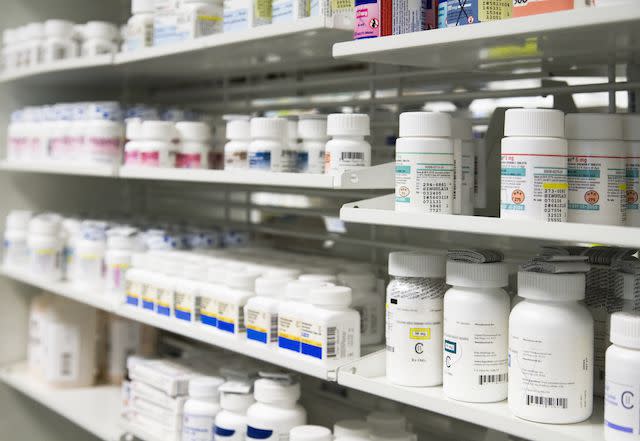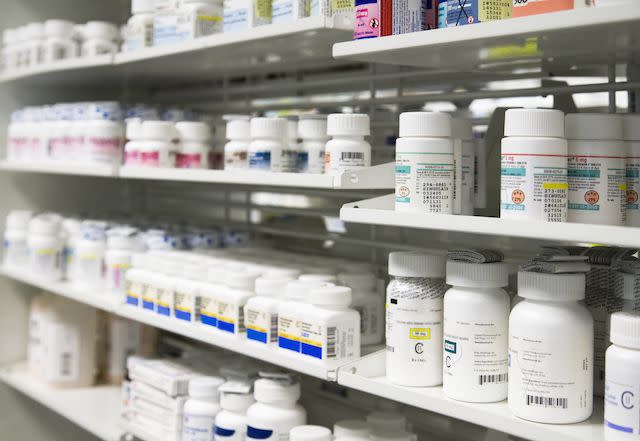What Is a High Dose of Prednisone?

Medically reviewed by Lindsay Cook, PharmD
Corticosteroids, or steroids, are prescribed to treat many conditions involving inflammation. Inflammation is the immune system's reaction against injury or infection. Steroids work by affecting the immune system and decreasing inflammation.
Steroids treat conditions such as asthma, rheumatoid arthritis (RA), lupus, multiple sclerosis (MS), eczema, different types of cancer, Crohn's disease, ulcerative colitis (UC), and others. Prednisone is a popularly prescribed steroid medication.
Steroids are potent (strong) medicines. As such, they can have serious side effects, mainly when used at high doses and for extended periods.
Because of these risks, healthcare providers prescribe prednisone at the lowest effective dose and for the shortest possible time.
One such popular steroid medication is prednisone, a drug used to lower symptoms of low corticosteroid levels.
However, a high-risk dosing schedule of prednisone varies based on the condition treated and individual factors. Continue reading to learn more about prednisone dosing and safety.

Prednisone Dosing
Healthcare providers prescribe prednisone at the lowest effective dose and for the shortest possible time. This will help lower the risk of severe side effects.
Dosage Forms of Prednisone
Prednisone is available in multiple forms of administration alongside varying strengths of prescription.
Moreover, it should be noted that while brand-name forms of prednisone exist, it is most commonly prescribed as generic prednisone.
For example, prednisone oral (taken by mouth) tablets are available in 1 milligram (mg), 2.5 mg, 5 mg, 10 mg, 20 mg, and 50 mg tablets.
Prednisone is also available as a delayed-release (DR) tablet (a form of medicine that delays the release of active ingredients after taking it, which can help control where it's released in the body) under the name Rayos.
Brand-name Rayos is available in 1 mg, 2 mg, and 5 mg DR tablets.
Prednisone is also available as an oral solution (a liquid form of administration).
Prednisone Dosage
Your prednisone dosage will vary based on your condition and your response to treatment. It's recommended that prednisone be taken with food to minimize stomach discomfort and side effects.
Generally, the starting dose is between 5 and 60 mg daily, although higher doses are sometimes required.
A lower dose may be appropriate for less severe symptoms, while others with more severe symptoms or conditions may require higher starting doses.
Depending on the length of treatment, the healthcare professional may provide a tapering schedule, where the amount is decreased over some time rather than stopping abruptly.
Doing so reduces the risk of severe side effects. People taking prednisone will be closely monitored for safety and side effects.
Additionally, prednisone should be stopped if a person does not respond to treatment after a reasonable period.
Some examples of higher prednisone dosing include:
Acute exacerbation (flare-up) of MS: 1250 mg daily (25 tablets of 50 mg) for three to five days
Hypercalcemia (high calcium levels in the blood) due to certain types of cancer: 50 to 100 mg daily for three to five days
Warning
Take prednisone exactly as prescribed. Do not take more prednisone than prescribed, and do not take it for longer than prescribed.
Follow your healthcare provider's instructions for tapering prednisone, and do not stop taking it abruptly unless directed by your healthcare provider.
Side Effects & Safety
Like other medications, prednisone can cause side effects. Tell your healthcare provider about any side effects you experience while taking this medication.
Below is a partial list of side effects, and others may occur. A healthcare provider can advise you on side effects.
If you experience other effects, please contact your pharmacist or a medical professional. You may report side effects to the U.S. Food and Drug Administration (FDA) at fda.gov/medwatch or 1-800-FDA-1088.
Common Side Effects
Common side effects of prednisone may include:
Hirsutism: Excess hair growth, which can occur in places such as the face, chest, and back
Cushingoid appearance (round face, fatty hump between the shoulders, acne, weight gain in the stomach, thin arms and legs, and light, easily bruised skin)
Weight gain
Stomach problems, such as stomach pain, nausea, and vomiting
Changes in appetite
Fluid retention
Hypertension (high blood pressure)
Hyperhidrosis (excess sweating)
Acne
Petechiae (tiny spots on the skin due to bleeding under the skin)
Abnormal skin coloring
Headache
Trouble sleeping
Hyperglycemia (high blood sugar)
Irregular menstrual cycles
Long-Term Side Efects
Side effects associated with long-term use of prednisone can be severe and can include, but are not limited to:
Osteoporosis (weak, brittle bones)
Glaucoma (a group of eye conditions that cause damage to a nerve in the eye and may cause vision loss or blindness)
Cataracts (clouding of the lens of the eye)
Immunosuppression (suppression of the body's immune system, which decreases its ability to fight infection)
Kaposi sarcoma (cancer that causes lesions in the soft tissues; it is more likely to affect immunosuppressed people)
Impaired wound healing (when wounds do not adequately heal)
Thinning skin
Cushing syndrome (a condition that occurs from too much cortisol)
Growth suppression in children
Severe Side Effects
More serious side effects of prednisone may include but are not limited to:
Anaphylaxis (severe allergic reaction): Get emergency medical help if you have urticaria, difficulty breathing, or swelling of the face, lips, tongue, or throat
Adrenal insufficiency: A profound, potentially life-threatening side effect of steroids where there is not enough cortisol (this may occur after taking prednisone for three weeks or longer)
Steroid psychosis: A severe side effect that may occur after taking a high dose of steroids, characterized by mood disturbances and psychosis (a disconnection from reality).
Muscle weakness
Cushing syndrome
Pseudotumor cerebri (increased pressure in the skull)
High blood pressure
Congestive heart failure (CHF)
Pancreatitis (inflammation of the pancreas)
Gastrointestinal perforation (hole in the digestive tract)
Peptic ulcer disease (sores on the lining of the esophagus, stomach, or small intestine)
Exophthalmos (bulging of the eye or eyes)
Osteonecrosis (bone tissue death caused by a lack of blood supply)
Tendon rupture (injury to the soft tissues that connect muscles and joints)
Call your healthcare provider right away if you have serious side effects. Conversely, call 911 if your symptoms feel life-threatening or if you think you have a medical emergency.
Side Effects and Safety
Prednisone may cause other side effects. Call your healthcare provider if you have unusual problems while taking this medication.
If you experience a severe side effect, you or your provider may send a report to the FDA's MedWatch Adverse Event Reporting Program or by phone (800-332-1088).
When to Take Prednisone
Prednisone can be used to treat many conditions that involve inflammation.
Your healthcare provider will determine if prednisone is appropriate based on your symptoms, medical condition(s), medical history, and other factors.
Who Shouldn't Take Prednisone?
Prednisone is not appropriate for everyone. Before taking prednisone, tell your healthcare provider about your medical conditions, medical history, and family history.
You should not take this medication if you are allergic to prednisone or any of the inactive ingredients in prednisone.
Other people who should not take prednisone include:
People with a systemic fungal infection (a fungal infection that affects the skin and organs)
People with cerebral malaria (a life-threatening brain complication of a malaria infection that can cause coma, brain injury, or death)
Prednisone may be prescribed with caution in some people only if the healthcare provider determines it is safe. This includes:
Children and adolescents
Immunosuppressed people
People with an infection or at risk of disease, including active or latent (inactive) tuberculosis infection
People who may be exposed to measles or herpes virus
People with high blood pressure, heart failure, or recent heart attack
People with diabetes
People with certain stomach conditions, such as ulcers, diverticulitis, or ulcerative colitis, or those who are at risk for stomach complications such as perforations (holes)
People who have seizures
People who have mental health conditions
People with thyroid conditions
People with or at risk for osteoporosis
People with myasthenia gravis (a condition that causes weakness and muscle fatigue)
People with ocular herpes infection (a viral infection of the eye caused by the herpes virus) or optic neuritis (inflamed optic nerve of the eye)
People who are at risk of pheochromocytoma (an adrenal gland tumor)
People with kidney or liver problems
If you are pregnant, planning to become pregnant, or breastfeeding, consult your healthcare provider for medical advice.
Prednisone Interactions
Tell your healthcare provider about all your medicines, including prescription and over-the-counter (OTC) drugs and vitamins or supplements.
While taking prednisone, do not start any new medications without approval from your healthcare provider.
Some drug interactions include:
While taking prednisone, avoid alcohol. Alcohol combined with prednisone can increase the risk of stomach bleeding, perforation (holes), and ulcers (sores).
While taking prednisone, you should not get a live vaccine such as the live measles/mumps/rubella vaccine. Because prednisone suppresses the immune system, your body may not adequately build an immune response to the vaccine, increasing your risk of infection.
While taking prednisone, you should not take certain forms of Ddavp (desmopressin). The combination could cause high blood pressure, water retention, and low sodium levels.
Drugs that increase the risk of bleeding have an even higher risk when combined with prednisone. Consult your healthcare provider if you take a blood thinner like Jantven (warfarin) or a nonsteroidal anti-inflammatory drug (NSAID) such as Motrin (ibuprofen).
Other drugs may affect prednisone, including Wellbutrin (bupropion) or Nizoral (ketoconazole). This also includes select antibiotics, water pills (diuretics such as Lasix [furosemide]), insulin, or oral/injectable diabetes medications.
This is not a complete list of drug interactions. Other drug interactions may occur with prednisone.
Consult your healthcare provider for more information about drug interactions and how they may affect you.
Summary
Prednisone is a steroid used to treat various conditions that involve inflammation. The dose that is prescribed is individualized based on many patient factors.
Because of the risk of side effects from long-term use, which can be severe, healthcare professionals are careful to prescribe the lowest effective dose of prednisone for the shortest time.
Consult your healthcare provider if you have questions or concerns about your prednisone dose and length of treatment.
Frequently Asked Questions
How long does prednisone stay in your system?
A dose of prednisone reaches its highest effect in one or two hours. Prednisone has a half-life (the time it takes for half the drug to be cleared from the body) of two or three hours, and it takes four to five half-lives for a drug to remove the body.
Therefore, a prednisone dose will take about eight to 15 hours to clear the body. However, if you continue to take prednisone, you will keep building up levels of the medication in your body, so it will not clear the body until about 8 to 15 hours after your last dose.
What is an example of an effective prednisone taper schedule?
Your healthcare professional will provide you with a personalized taper schedule. An example of a tapering program is decreasing the prednisone dose by 2.5 to 5 mg every three to seven days.
However, everyone is different, so follow the plan given by your healthcare provider.
Methylprednisolone vs. prednisone: How do they compare?
Methylprednisolone, like prednisone, is a corticosteroid. Methylprednisolone is available as a tablet as well as various injectable formulations. The injectable formulation may be used when someone cannot take oral prednisone.
They treat many of the same conditions and have similar side effects and warnings. Depending on the situation, your healthcare provider may recommend one.

